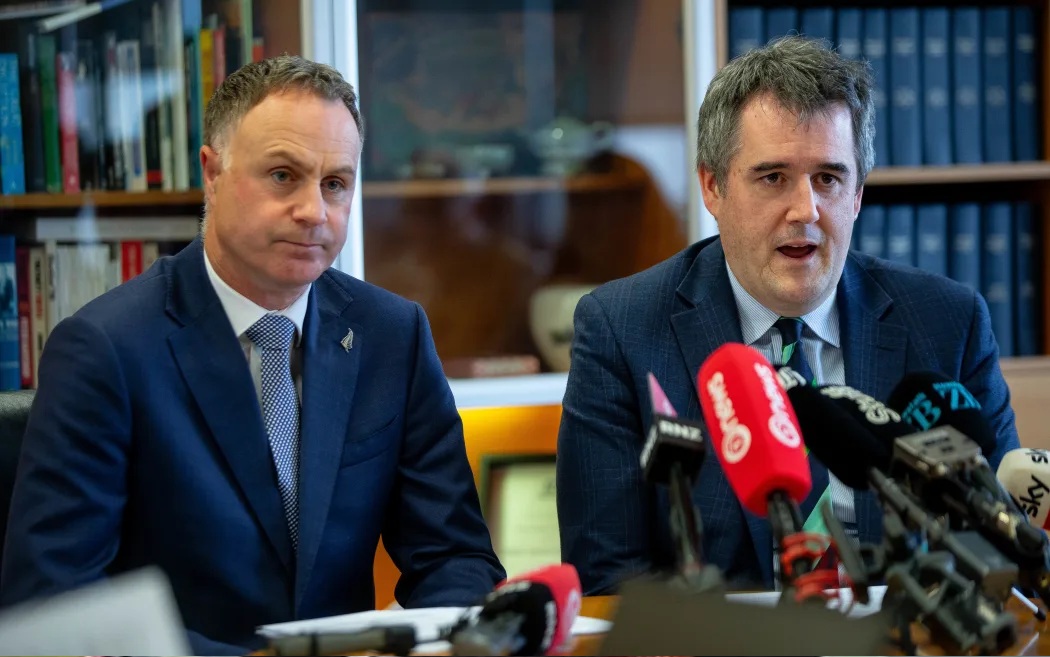
Mayors of city and district councils would take over the duties of regional councils, in a coalition proposal pitched as the biggest shake-up of local government in three decades.
The mayors would form 11 Combined Territories Boards (CTBs), which would meet regularly and - on top of handling the business of regional councils - would be tasked with coming up with a "Regional Reorganisation Plan" for reorganising how their councils are structured in the long term.
The CTBs would also have responsibility under the government's RMA reforms for developing the region-wide spatial plan chapter, and a national environment plan chapter, to be included in combined regional plans.
The changes are now out for consultation, which remains open until February 20, with the resulting legislation expected to be introduced mid-next year and passed in 2027.
Local Government Minister Simon Watts and RMA Reform Minister Chris Bishop announced the moves on Tuesday, releasing the details at 5pm to avoid spooking the markets due to regional councils' ownership of port companies around the country.
"Local government is meant to serve communities, not confuse them, but right now the system is tangled in duplication, disagreements and decisions that defy common sense," Bishop said.
He said he expected the changes would put "downward pressure" on rates.
"The government's belief is that local government has lost the social licence and that New Zealanders have lost faith in local government - this is borne out by the fact that over half don't bother to vote in local elections."
He said it was clear to many the current structure was no longer fit for purpose, and the "status quo is not an option".
Bishop said he could not guarantee the current elected regional councillors would stay in those roles for their full three-year term, only saying "it's an option".
"I think most New Zealanders, fair-minded people, look at our current local government system and say we need change," he said.
The government's impending replacement of the Resource Management Act would mean a reduced role for regional councils, he said, with fewer plans and fewer consents - and presented a "once-in-a-generation opportunity" to "reset" the structure of local government.
"Change is hard, and actually this government was elected to make tough decisions."
Mayors would likely have a set number of votes on these boards based on population, but adjusted to ensure smaller communities still had a voice - although this was one of multiple options proposed.
A discussion document released alongside the decision gave three options for filling out the Combined Territories Boards with Crown Commissioners, to ensure the system "works in practice" by giving the government a stronger role.
These included:
- Observer only - the Crown Commissioner has no vote
- Veto power - the Crown Commissioner can override CTB decisions
- Majority vote - the Crown Commissioner has more than half the votes on the CTB with the remaining votes distributed among mayors
Watts said a "fair and balanced voting system" would ensure both regional and urban interests were represented in decisions about land and water.
The change would mean more efficient services, greater accountability, and smarter use of ratepayer funds, he said.
"This is not a one-size-fits-all approach. It is a framework for regions to design what works best for them with clear expectations that the outcome must be better than what exists today... crucially, it is also not about centralising power. This is about empowering local leaders to lead their own reform."
"It's not a power grab," Bishop said. "This is about making local government fit for purpose."
As well as taking on the roles of Regional Councils, the boards would have two years from establishment to produce their Regional Reorganisation Plans (RRPs) which would then be assessed against "clear national criteria" before approval by the Local Government Minister.
"Importantly, ministerial approval does not bypass community input," the discussion document said. "Public consultation by the CTB is required before any plan is finalised."
The document said the alternative would be to hold a referendum which were "costly and slow" and typically had low voter turnout and a tendency to favour the status quo.
New Zealand has 11 regional councils tasked with resource management including flood protection and air quality, public transport, pest control, civil defence and more.
They were set up as part of the 1989 local government reforms to replace more than 700 local boards and the roles of the former county councils.
The regional councils are separate from the 67 "territorial" authorities - city and district councils - which handle roads, water services, waste and recycling collection, parks and libraries, public safety bylaws.
New Zealand also has six unitary authorities which combine the powers and responsibilities of both a regional council and a territorial authority.
Bishop said the reorganisation plans may end up leading to more unitary authorities. He said there was a "strong lobby" for having more unitary authorities, and many in the local government sector had been calling for local mayors to simply be given the responsibilities of regional councils.
Watts said the changes were "absolutely" consistent with National's rhetoric around localism and devolution, as the different layers of local governments were often in competition with each other and it would instead mean more streamlined services and more accountability.
Treaty of Waitangi settlement obligations would be carried over.
Existing unitary authorities would have the opportunity to also produce Reorganisation Plans, but would not be required to.
Regional and district boundaries would remain unchanged, at least until further decisions were made under the RRPs.
However, some districts like Rotorua and Taupō have populations in more than one region - so the government proposes two options:
- to either have those areas "adopted" into a neighbouring district, with an option to have those districts able to vote on which neighbouring mayor would represent them
- give these districts a voting share in each of the regional groups they are covered by, with proportionate votes and possibly with local ward councillors to represent them instead of the mayor
The discussion document also noted regional constituencies "including Māori constituencies and general constituencies, would no longer exist".
"This is because regional councillors themselves would be replaced by the mayors in the region ... the mayor of the city or district council would represent voters from the Māori and general rolls."














